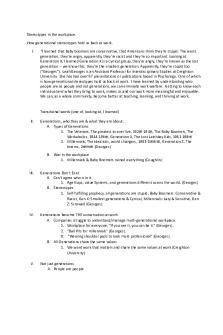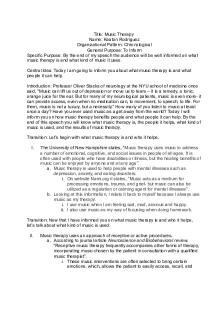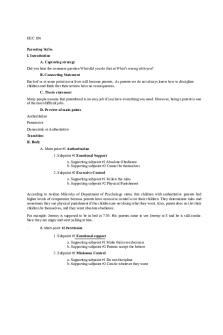Informative Speech PDF

| Title | Informative Speech |
|---|---|
| Course | Intro to Public Speaking |
| Institution | University of Akron |
| Pages | 5 |
| File Size | 81.2 KB |
| File Type | |
| Total Downloads | 3 |
| Total Views | 142 |
Summary
speech to inform ...
Description
Grace Kasunic Informative Speech- Lucid Dreaming Thesis: I want my audience to learn about lucid dreaming. Introduction: Close your eyes and remain as still as still as possible. Can any of you remember without looking what the person next to you is wearing today? Maybe what color the walls behind me are? Can you remember exact details about the simple things that happened to you in the short time before this class began? Maybe you can, or maybe not. Regardless, you are aware of the fact that I asked you to close your eyes and think. Open your eyes. Lucid dreaming is a topic that has always interested me due to the way it allows for higher levels of thinking and the way it can empower an individual's mind. Today I will be informing you on what exactly lucid dreaming is, some of the benefits of lucid dreaming, and even explain how you can become a lucid dreamer. Body 1: According to medicinenet.com, lucid dreaming is the process of being aware of the fact that one is dreaming while dreaming. The dreamer is able to consciously manipulate the narrative, setting, and plot of the dream. This same site contrasts lucid dreaming to conscious dreaming by stating that in normal dreams, the conscious part of the brain is “shut down” causing one to not remember dreams or make them blurry when the person wakes up. In a lucid dream, the dreamer is fully aware of what is going on. According to Zach Busby, a graduate student at Macalester College, lucid dreaming was first mentioned by Marquis d’Hervey in 1867. Most people negated his research and even stated that he was insane. Busby’s research also states that the first published evidence of lucid dreaming was in 1980, when Stephen LaBerge used a
process involving sleep studies to track the eye movements of lucid dreamers. The process LaBerge used was revolutionary for the time, but scientists and the culture were still hesitant to believe in the scientific aspect of lucid dreaming. Matthew Walker, a neuroscience professor at Cal U, Berkeley, has developed a study to validify the existence of lucid dreaming. His study utilizes fMRI scanners, which measure the rate of blood flow to different areas of the brain so they can relay information about a person’s thoughts and actions through images. In the study, lucid dreamers were asked to clench their fists repeatedly, while awake, while their brain was analyzed with fMRI scanner. Then, they were asked to fall asleep and dream about clenching their fist. Similar regions of the brain lit up in both cases, meaning that the person was able to “control” their dream. This study also helped to identify when lucid dreaming occurs. In a normal sleep cycle, there are 5 stages one undergoes. Lucid dreaming is said to occur in the REM stage of sleep -- or rapid eye movement. This is the deepest stage of sleep and where powerful dreams occur. Now that you know what lucid dreaming is, I will help explain some of the benefits of lucid dreaming. Body 2: Lucid dreaming is much more than simply being able to control your dreams. Lucid dreaming has been stated by Psychology Today as being used for therapy, enlightened spirituality, increasing creativity, practicing and improving real life skills, and getting better, more restful sleep just to name a few. Lucid dream researcher Beverly D’Urso explains these benefits as follows: this type of dreaming can be used for therapy in order to remove extreme fears from one’s brain. As the saying goes, the best way to remove a fear is to face it and experience it over and over again. Using lucid dreaming, one can manipulate their dreams into a
realistic version of a fear and experience it over and over again and have it end with a more pleasant outcome than what their brain has trained them to be afraid of. Lucid dreaming teaches a person to be more aware of their surroundings and being able to focus on the importance of being in the moment. This can help with spirituality by being able to focus on your thoughts without being sidetracked or distracted. Lucid dreaming helps you to get back in touch with your child like imaginations and boost your creativity. It lets you tap into unlimited sources of inspiration, which is also proven to help increase happiness in people. Lucid dreamers have also reported dreaming constantly about practicing a skill such as juggling, and then actually being a better juggler in real life. According to a poll in Life Evolver that D’Urso states in her researcher that over 50% of lucid dreamers report being significantly less tired than if they do not lucid dream. This is in large due to the fact that lucid dreamers tend to spend more time in the REM stage of sleep without being interrupted, helping them to achieve better sleep. Most people think that either you are born a lucid dreamer or you are not. Body 3: According to TechInsider, only 20-30% of the population are natural lucid dreamers. This does not mean, however, that does not mean that the rest of the world is unable to lucid dream. Daniel Steinbock, a neuropsychological researcher, hosts a workshop every year that actually teaches people how to lucid dream. Here is the basic premise of this workshop. According to Steinbock, lucid dreaming requires 4 disciplines: Sleeping, waking, walking, and dreaming. He says that in order to lucid dream it is important to gt enough unconscious sleep in order to be well rested before beginning to lucid dream, that you should wake gently and slowly-concentrating on only your dreams while you begin to awake. On walking, Steinbock says to
also think about the details of your dreams throughout the day and to periodically stop and force yourself to become aware of the fact that you are awake and this is reality. For actual lucid dreaming, Steinbock states that it is important to resist the urge to wake up once you become aware of the fact that you are dreaming, and also that in order to control your dreams-- you must control your thoughts and desires and negate any doubts that your mind tries to offer you. For example, if in your dream you want to fly, you have to concentrate only on flying, rather than the consequence of falling. Conclusion: Clearly, lucid dreaming is so much more than simply realizing that you are in a dream while dreaming. If you want to become a lucid dreamer, start with being more aware of your surroundings and details while you are awake. So, stop and think: did you dream last night? Do you remember the dreams? Either way, maybe tonight you will try and lucid dream and unlock a whole new world inside your mind.
Works Cited Busby, Zach. “Scientific History of Lucid Dreaming.” REM Sleep , www.macalester.edu/projects/ UBNRP/Website_REM_Sleep/lucidHistory.html. “How To Remove Fears And Phobias With Lucid Dreaming.” HowToLucid.com , 15 Nov. 2016, howtolucid.com/remove-fears-with-lucid-dreaming/. Kim, Gene. How Lucid Dreaming Works. Performance by Matthew Walker, YouTube , YouTube, 21 Jan. 2018, www.youtube.com/watch?v=qH-MGqokk_Y. “Lucid Dreaming and Self-Realization.” Psychology Today , Sussex Publishers,www.psycholo gytoday.com/us/blog/the-superhuman-mind/201212/lucid-dreaming-and-self-realization. Ralston, Derek. “The Effect of Lucid Dreaming on Sleep Quality.” Life Evolver , 15 Sept. 2018, www.lifeevolver.com/lucid-dreaming-effect-sleep-quality/. Steinbock, Daniel. “4 Steps to Lucid Dreaming.” Daniel Steinbock , Sept. 2010, steinbock.org/ writings/4-steps-to-conscious-dreaming/. “10 Incredible Benefits Of Lucid Dreaming, And Why They Matter.” HowToLucid.com , 18 Nov. 2016, howtolucid.com/lucid-dreaming-benefits/....
Similar Free PDFs

Informative speech
- 4 Pages

Informative Speech
- 3 Pages

Informative speech
- 3 Pages

Informative Speech
- 3 Pages

Informative Speech
- 3 Pages

INFORMATIVE SPEECH
- 6 Pages

Informative Speech
- 3 Pages

Informative Speech
- 8 Pages

Informative Speech
- 5 Pages

Informative speech
- 4 Pages

Informative Speech
- 2 Pages

Informative Speech Outline
- 5 Pages

Informative Speech Rubric
- 3 Pages

Informative Speech Outline
- 5 Pages
Popular Institutions
- Tinajero National High School - Annex
- Politeknik Caltex Riau
- Yokohama City University
- SGT University
- University of Al-Qadisiyah
- Divine Word College of Vigan
- Techniek College Rotterdam
- Universidade de Santiago
- Universiti Teknologi MARA Cawangan Johor Kampus Pasir Gudang
- Poltekkes Kemenkes Yogyakarta
- Baguio City National High School
- Colegio san marcos
- preparatoria uno
- Centro de Bachillerato Tecnológico Industrial y de Servicios No. 107
- Dalian Maritime University
- Quang Trung Secondary School
- Colegio Tecnológico en Informática
- Corporación Regional de Educación Superior
- Grupo CEDVA
- Dar Al Uloom University
- Centro de Estudios Preuniversitarios de la Universidad Nacional de Ingeniería
- 上智大学
- Aakash International School, Nuna Majara
- San Felipe Neri Catholic School
- Kang Chiao International School - New Taipei City
- Misamis Occidental National High School
- Institución Educativa Escuela Normal Juan Ladrilleros
- Kolehiyo ng Pantukan
- Batanes State College
- Instituto Continental
- Sekolah Menengah Kejuruan Kesehatan Kaltara (Tarakan)
- Colegio de La Inmaculada Concepcion - Cebu

